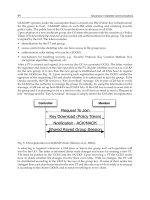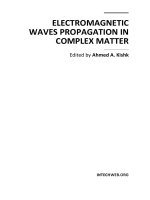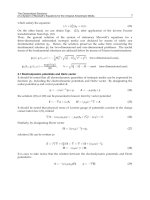Electromagnetic Waves Propagation in Complex Matter Part 8 potx
Bạn đang xem bản rút gọn của tài liệu. Xem và tải ngay bản đầy đủ của tài liệu tại đây (574.7 KB, 20 trang )
Electromagnetic Waves in Contaminated Soils
127
(a)
(b)
Fig. 2. Antennae: (a) Monopole antenna derived from a coaxial cable by removing a part of
outer conductor, (b) a UHF–Half–Wave Dipole (Wikipedia, 2011).
5.1 Monopole antenna case (A)
The pilot-scale simulation of the SoilBED facility (Farid et al., 2006) is explained in this
section. In the first case, a 5 mm-thick monopole antenna is modeled within a fully saturated
sandy soil background. The size of the medium under study was selected to satisfy
limitations of the FDTD code as well as the experiment. Table 2(a) summarizes details about
the geometry and grid size of the soil medium. The simulation is driven by a cosine
modulated Gaussian time pulse at a reasonably high frequency (1.5 GHz). To accommodate
the simulation of the dispersive soil and stability of the FDTD code at this frequency, the
time increment Δt = 2 psec was used. The dispersive properties of the soil for this choice of
center frequency and time-step are modeled with the Z-transform function coefficient
set
A
ve
, a
1
, b
0
, b
1
, and b
2
, given in Table 2(b).
To relate the results to the field site, the model can be scaled up in size while scaling down
the frequency. To evaluate the feasibility of the DNAPL detection method using monopole
antennae, wave propagation through the background soil and scattered EM wave
propagation by a DNAPL pool were modeled and analyzed. The geometry details of the
monopole transmitting antenna modeled in this case are tabulated in Table 2(c). The drive
signal excites the top of the simulated coaxial cable feeding the monopole antenna in a
conventional radial field pattern. The electric field components on all grid points of different
cross-sectional and depth slices of the medium were computed and then visualized using
MATLAB.
Electromagnetic Waves Propagation in Complex Matter
128
First, the background medium was analyzed. Then, a rectangular acrylic plate as a
representative of a DNAPL pool was modeled within the soil medium. Fig. 3 schematically
shows the simulated geometry (the monopole antenna, the DNAPL pool, and the soil
medium). Details of the geometry of the DNAPL pool scatterer are listed in Table 2(d).
Fig. 3. SoilBED, antenna, observation slice and rectangular DNAPL pool (3 cm × 3 cm × 1 cm).
Geometry Size
Simulated grid 149 × 149 × 29
Grid cell size 0.2 cm × 0.2 cm × 1 cm
Entire grid size 29.6 cm × 29.6 cm × 28 cm
Soil thickness 21 cm
Air thickness 7 cm
Table 2.a. Details of the simulated medium
Parameter Value
A
ve
(Dielectric Permittivity)
20.9
a
1
-0.8985
b
0
-34.3627
b
1
68.7577
b
2
-34.3945
* Due to solving the problem at Δt = 2 psec, the FDTD code is very sensitive, and all digits are necessary
to satisfy the stability conditions
Table 2.b. Soil properties, used for the simulation of the fully saturated sandy soil at f = 1.5
GHz,
t = 2 psec, and 17% gravimetric moisture content (w)
Electromagnetic Waves in Contaminated Soils
129
Antenna Details Size
Antenna depth 120 mm
Perfectly conducting core wire thickness 1 mm
Extended dielectric length 20 mm
Extended dielectric thickness 3 mm
Perfectly conducting outer conductor (shield) thickness 3 mm
Frequency 1.5 GHz
Gaussian width 0.667 nsec
Gaussian peak 5 nsec
* The dielectric constant and effective electrical conductivity of the extended dielectric of the antenna
are respectively assumed to be 2.1 and zero (Ω
-1
).
Table 2.c. Geometry details of the simulated monopole antenna
DNAPL Pool Geometry Size
Horizontal cross-section 3 cm × 3 cm × 1 cm
Depth 9 cm
Clear separation from the antenna 3.8 cm
Coordinate of the pool center* 6 cm, 0 cm, -2 cm
* With respect to the center of the grid
Table 2.d. Details of the DNAPL pool scatterer
To evaluate the wave propagation, the following observation slices were selected. Different
components of electric field were computed and visualized on these slices.
A cross-sectional (horizontal: XY-plane) slice, cutting through the antenna and DNAPL
pool at the depth of 9 cm. Z and X components of the electric field (E
z
and E
x
) are shown
on this slice in Fig. 4.
Up to this point, only the three vector components of the electric field were visualized.
Now, the power is depicted. The intensity of a rapidly varying field is often displayed
on a dB scale, enabling the visualization of small amplitude levels. This scale is given by
20 log
10
|E / E
max
|. It is important to note that on the selected depth slice, E
y
equals 0,
and hence
E = E
x i
+E
z k
. In addition, since the time domain signals are all purely real,
but may have positive or negative values, the dB scale is artificially augmented with
positive values to indicate negative field values and better display the oscillating nature
of the rapidly decaying wave. The sign of corresponding
E
z
governs the sign of the dB
value. It should be stressed that 0 dB is the maximum field intensity, and positive dB
values correspond to weaker signals with the opposite sign.
A depth (vertical: XZ-plane) slice, passing through the antenna and DNAPL pool. This
slice (XZ-plane) was chosen because the YZ-plane does not intersect the DNAPL pool.
Due to symmetry,
E
y
is zero on this XZ slice, and hence |E| can be computed by only
E
x
and E
z
. Results are shown in Fig. 5.
Electromagnetic Waves Propagation in Complex Matter
130
(a)
(b)
Electromagnetic Waves in Contaminated Soils
131
(c)
(d)
Electromagnetic Waves Propagation in Complex Matter
132
(e)
(f)
Fig. 4. Electric field simulated on the cross-sectional slice (XY-plane) at t = 3.6 nsec (the
extent of the DNAPL pool is marked by a yellow box): Z-component of the electric field: a)
Incident, b) Total, and c) Scattered; and X-component of the electric field: d) Incident, e)
Total, and f) Scattered.
Electromagnetic Waves in Contaminated Soils
133
(a)
(b)
Electromagnetic Waves Propagation in Complex Matter
134
(c)
Fig. 5. Electric field [Sign(E
z,Total
- E
z,Incident
)] × 20 log
10
(|E| or |E
x i
+E
z k
|
), on the depth
slice (XZ-plane) at time
t = 3.6 nsec (the extent of the DNAPL pool and soil-air interface are
marked in yellow): a) Incident image, b) Total image, and c) Scattered image.
This case was initially analyzed without DNAPL contamination (incident field or
background) and then with the DNAPL pool (total field). The scattered field by the DNAPL
pool target can be computed by subtracting the two previous fields. Three figures are shown
for each slice and for each electric field component and for: (i) “incident” (i.e., background,
no target), (ii) “total” = background + DNAPL pool target as the scatterer, and (iii)
“scattered” (i.e., signature of the target). All results shown in Fig. 4 are captured at
t = 3.6
nsec. As seen, incident results of Figs. 4(a) and 4(d) are symmetric, while the total field
results shown in Figs. 4(b) and 5(e) are not symmetric. The resulting scattered field
information shown in Figs. 4(c) and 4(f) is asymmetric as well.
The incident, total, and scattered (target signature) fields are shown in Fig. 5. The monopole
antenna was modeled as a Z-polarized antenna. Therefore, the Z-component of the electric
field is the major component, but the scattered field by the DNAPL pool is also readily
visible on the X and Y component plots. Since
E
z
dominates and the scattered field is visible
on the Z-component (Fig. 5(c)), the scattered field shown on the dB plot will be clear as well.
Further studies (that do not fit in this chapter) show weaker scattered Z-component in dry
sandy soils. Different components can be experimentally measured using a receiving
antenna with a different polarization (e.g., an X or Y polarized antenna, which is simply a
monopole placed horizontally) than the Z-polarized (vertical) transmitting antenna. The
scattered field is comparable to the incident field in this case. This potential can also be
demonstrated in a different form as shown in Fig. 6.
Electromagnetic Waves in Contaminated Soils
135
This figure shows that there is a considerable magnitude and travel time difference between
the total and incident fields received at a receiver located right above the DNAPL pool. The
strong magnitude difference (more than 100%) and time difference (around 100 psec)
between the two signals illustrate the potential of the cross-borehole GPR method to detect
DNAPL pools. The early arrival of the total field is caused by the increase in the velocity of
EM waves through the DNAPL pool due to its lower dielectric permittivity compared to the
saturated soil. The increase in the magnitude of the total field is, on the other hand, caused
by lower loss through the DNAPL pool due to its lower electrical conductivity. This
illustrates a great potential for DNAPL detection using CWR in saturated soils, if the
thickness and size of the pool is a reasonable fraction of the wavelength.
Fig. 6. Z-component of total and incident electric fields due to the monopole antenna,
received at a receiver located right above the DNAPL pool.
5.2 Dipole antenna case (B)
The above-mentioned small size monopole case can be scaled up to a more realistic size
contaminated site. However, scaling up the results may cause some problems that do not
allow a simple and direct generalization from small numerical models to real size
contaminated sites. For example, in a non-dispersive medium, linear enlargement of the size
can be simply interpreted to a linear increase in the wavelength and decrease in the
frequency. However, in a dispersive medium, any change in the frequency causes variations
in the dielectric properties of the medium. This change in the dielectric constant causes
variations in the wave velocity, which in turn adds nonlinearity to the scaling process from
the simulated medium up to the real size.
Therefore, to evaluate the scaling issues in a dispersive medium and study the effect of
different radiation patterns of different antennae, another case with a more realistic size of
soil medium surrounding a dipole antenna was modeled. The dipole is also larger than the
monopole, since the smallest object to be modeled (the antenna) controls the uniform grid
size in X and Y directions and size limitations of the FDTD code. The details about the grid
size and the geometry of the soil medium for this case are tabulated in Table 3(a).
Electromagnetic Waves Propagation in Complex Matter
136
To decrease the computation cost, a much larger grid cell (3 cm in X and Y directions, and 5
cm in Z direction) was modeled (Table 3(a)). To satisfy sampling limitations (grid size <
λ /
10
) and study the scaling effect, the wavelength should be larger. Therefore, the frequency
was selected to be 100 MHz (lower than 1.5 GHz in Case A). To satisfy the Courant’s
condition for the new grid size, the time increment was increased to
Δt = 50 psec.
Geometry Size
Simulated grid 149 × 149 × 69
Grid cell size 3 cm × 3 cm × 5 cm
Entire grid size 444 cm × 444 cm × 340 cm
Soil thickness 305 cm
Air thickness 35 cm
Table 3.a. Details of the simulated medium
The soil medium is exactly the same fully water-saturated sandy soil modeled in the
previous case with 17% gravimetric moisture content. However, dielectric properties of the
dispersive soil at the different frequency and time increments (
f = 100 MHz, and Δt = 50
psec) are different. Therefore, the dielectric constant and coefficients (
ε
Ave
, a
1
, b
0
, b
1
, and b
2
) of
the Z-transform function required to model the dispersive electrical conductivity of the soil
were recomputed for the new frequency and time increment. The new soil parameters are
listed in Table 3(b). A center-fed resistively tapered
½ wavelength dipole antenna is
modeled as the transmitter. The particular details of the resistive dipole are avoided by
modeling the antenna electromagnetically as simply a tapered half-wave surface current
source residing on the exposed coaxial insulator (maximum at the center, the point where
the feed line joins the elements, and zero at the ends of the elements). This type of antenna
may be used in a PVC-lined borehole filled with water. Therefore, the model simulates the
antenna surrounded by water. Obviously, to model the dispersive nature of water and
maintain the symmetry and accuracy on the circular interface around the antenna, water is
modeled using the same technique used to model lossy dispersive soils (Weedon &
Rappaport, 1997). For the same reason, the dielectric portion is modeled using the same
technique used for lossy dispersive soils, despite the non-lossy and non-dispersive nature of
the dielectric material. The PVC casing was ignored during the simulation to simplify the
Parameter Value
Ave
(Dielectric Permittivity)
14.9251
a
1
-0.8985
b
0
1.04948
b
1
-1.9896
b
2
0.94093
* Due to solving the problem at Δt = 50 psec, the FDTD code is very sensitive, and all digits are
necessary to satisfy the stability conditions.
Table 3.b. Soil parameters, used for the simulation of the fully saturated sandy soil at f = 100
MHz,
Δt = 50 psec, and 17% gravimetric moisture content
Electromagnetic Waves in Contaminated Soils
137
modeling and because the wall of the PVC is very thin compared to the wavelength (780
mm) of the EM wave. The dipole antenna is Z-polarized and the excitation signal is a 100
MHz cosine-modulated Gaussian pulse, progressively delayed along the antenna in the Z-
direction (i.e., points along the Z-directed dipole are excited with a progressive phase delay
proportionate to the traveling time of the current fed through the midpoint and along the
dielectric portion of the dipole). Table 3(c) summarizes the details about the structure of the
dipole antenna.
Antenna Details Size
Antenna depth 1800 mm
Borehole diameter 240 mm
Perfectly conducting core wire thickness 22 mm
Extended dielectric length 500 mm
Extended dielectric thickness 64 mm
Perfectly conducting outer conductor (shield) thickness 43 mm
Depth of water-filled borehole 500 mm
Frequency 100 MHz
Gaussian width 10 nsec
Gaussian peak 75 nsec
* The dielectric constant and effective electrical conductivity of the extended dielectric are respectively
assumed to be 2.1 and zero (Ω-1).
Table 3.c. Details of the simulated dipole antenna
First, the wave propagation through the soil background was analyzed. Then, a rectangular
DNAPL pool was modeled within the soil medium. Fig. 7 schematically shows the geometry
of this DNAPL pool. The details about the geometry of the DNAPL pool scatterer are listed
in Table 3(d).
DNAPL Pool Geometry Size
Horizontal area 45 cm × 45 cm × 15 cm
Depth 90 cm
Clear distance to the antenna 22.5 cm
Coordinate of the pool center* 90 cm, 0 cm, 45 cm
* With respect to the center of the grid
Table 3.d. Details about the DNAPL pool scatterer
Similar to Case A, the transmitting antenna is modeled in the code, but rather than
modeling receiving antennae, the three different components of the electric and magnetic
fields are computed at all grid points on the following depth and cross-sectional slices.
A cross-sectional (horizontal: XY-plane) slice, cutting through the antenna and DNAPL
pool at the depth of 90 cm. Z and X components of the electric field (
E
z
and E
x
) are
shown on this slice (Fig. 8).
A depth (vertical: XZ-plane) slice, passing through the antenna and DNAPL pool. The
magnitude of the power, derived from both
E
x
and E
z
, is shown on this slice in Fig. 9 (E
y
is zero on this slice due to symmetry).
Electromagnetic Waves Propagation in Complex Matter
138
Fig. 7. Schematic representation of the borehole dipole antenna geometry and DNAPL pool
(45 × 45 cm × 15 cm).
(a)
Electromagnetic Waves in Contaminated Soils
139
(b)
(c)
Electromagnetic Waves Propagation in Complex Matter
140
(d)
(e)
Electromagnetic Waves in Contaminated Soils
141
(f)
Fig. 8. Electric field simulated on the cross-sectional slice (XY-plane) at
t = 90 nsec (the extent
of the DNAPL pool is marked by a yellow box): Z-component of the electric field: a)
Incident, b) Total, and c) Scattered X-component of the electric field: d) Incident, e) Total,
and f) Scattered.
(a)
Electromagnetic Waves Propagation in Complex Matter
142
(b)
(c)
Fig. 9. Electric field,
[Sign(E
z,Total
- E
z,Incident
)]
20 log
10
(|E| or |E
x i
+E
z k
|), on the depth
slice (XZ-plane) at time
t = 90 nsec (the extent of the DNAPL pool and soil-air interface are
marked in yellow): a) Incident image, b) Total image, and c) Scattered image.
Electromagnetic Waves in Contaminated Soils
143
As before, for each slice and each electric field component, three figures are shown: (i)
incident (background) field, (ii) total field, and (iii) scattered field. As seen in Figs. 8(a) and
8(d), background results are symmetric. The total fields of Figs. 8(b) and 8(e) and the
scattered field shown in Figs. 8(c) and 8(f) are asymmetric. The interesting and encouraging
point is the visibility of the DNAPL pool over the entire medium within the total and
scattered fields, even on the far side of the pool from the antenna. This predicts that dipole
antenna boreholes of the CWR method can be drilled far from DNAPL-contaminated zones
to reduce the risk of further vertically downward penetration of DNAPLs associated with
drilling through contaminated zones. This appears to be more valid at higher degrees of
water-saturation. Again, this potential can also be demonstrated in a different form as
shown in Fig. 9.
Previously, in the case of the monopole transmitter, the received total and incident signals
were computed at a receiver located right above the DNAPL pool. Now, the two are computed
for a receiver located 175 cm above the pool to examine the possibility of minimizing the
destructive effect of placing the receiving antenna too close to the pool. This figure again
demonstrates a strong magnitude and travel time difference between the total and incident
fields received at the receiver located far above the DNAPL pool. The strong magnitude
difference (around 40%) and time difference (around 2.5 nsec.) between the two signals, once
again, embraces the potential of the use of the cross-borehole GPR method to detect DNAPL
pools. As in the monopole case, the early arrival of the total field and its higher magnitude can
be respectively justified by the higher velocity of EM waves through the DNAPL pool due to
its lower dielectric permittivity (relative to the water-saturated soil) and the lower loss due to
the pool’s lower electrical conductivity. The dry soil case has been studied (it does not fit in the
extent of this chapter) and proved to have weaker scattered signals, but still strong enough to
have the potential to detect DNAPL pools using relatively widely spaced antennae.
As expected for the radiation pattern of dipoles, most of the energy is transmitted
perpendicularly to the antenna through the mid-part of the antenna into the soil. The
modeled dipole antenna is Z-polarized, and thus the Z-component of the electric field is the
major component. The monopole antenna behaves similarly to the dipole antenna, the only
difference being the strong signature of the DNAPL pool on the Z-component as well as X
and Y components in the case of the dipole antennae. This wider spread perturbation due to
the clutter promises more potential detection key-points for the dipole antenna installation.
It is noteworthy that the perturbation due to the object on the X and Y components of the
electric field of both monopole and dipole antennae appears more to the sides of the
contaminated zone and perpendicular to the line connecting the center of the contaminated
zone and the antennae. The perturbation on the Ez component in the monopole antenna
case is distributed throughout the contaminated zone, while for the dipole one, this
perturbation spreads to the far side across the contaminated zone as well.
6. Comparison with monopole experimentation
In this section, the numerically simulated monopole case is compared with experimentation
for validation. The experimental setup (for more information refer to Farid et al., 2006) uses
two PVC-cased ferrite-bead-jacketed monopole antennae connected to a vector network
analyzer (Agilent 8714ES), and frequency-response measurements were collected for a
homogeneous water-saturated sandy soil background. Fig. 11 shows a schematic of the
experiment.
Electromagnetic Waves Propagation in Complex Matter
144
Fig. 10. Z-component of total and incident electric fields due to the dipole antenna, received
at a receiver located 175 cm above the DNAPL pool.
Fig. 11. Pulse traveling through transmitter, soil and then receiver
The frequency-response measurements are collected across the frequency range of 0.4 to 2.2
GHz. The frequency-response measurements are, then, transformed to the time domain
using an inverse fast Fourier transform (IFFT) and an assumption of a narrow-width,
wideband Gaussian pulse as the transmitted signal. Both the experiment and the FDTD
model use the same Gaussian pulse source. Due to the frequency range used in the
experimentation (0.4 GHz to 2.2 GHz), the width of the Gaussian signal should not exceed a
Electromagnetic Waves in Contaminated Soils
145
maximum of: W
min.
= 1 / f
max.
= 1 / 2.2 GHz = 0.455 nsec. Using narrower signals seems to
create a noise. Therefore, the upper limit (0.455 nsec.) is selected as the width of the signal.
Fig. 12 shows the transmitted signal.
0 1000 2000 3000 4000 5000 6000
0
0.1
0.2
0.3
0.4
0.5
0.6
0.7
0.8
time (x 2psec)
Amplitude (V/m)
Fig. 12. X- and Y-components of the radial excitation at the end of the feed cable into the top
of the transmitting antenna (
E
x1
= E
y1
, = 0.7 V/m, E
z1
= 0, and |E| = 1 V/m)
The FDTD-simulated received signal at the bottom of the receiving antenna is shown in Fig.
13(a). As seen, this received signal is distorted and does not resemble the Gaussian
transmitted one. Therefore, its peak is not easily distinguishable, since the received signal is
modulated and noisy. To resolve this issue, the received signal should first be demodulated
and then low-pass-filtered. The demodulation frequency can be found by observing the
received signal in the frequency domain (computed via a fast Fourier transform). This
demodulation frequency is observed to be dependent on the separation between the
transmitting and receiving antennae. A MATLAB code was prepared to automatically
observe the received signals in the frequency domain, find the proper demodulation
frequencies, and find the proper low-pass filter to filter the noise. The processed received
signal is shown in Fig. 13(b).
The travel time of the FDTD model can be simply calculated as the difference between the
peak times of the received (Fig. 13(b)) and transmitted (Fig. 12) signals.
To transform the experimental frequency-response to the travel-time, the transmitted signal
is fast Fourier transformed to the frequency domain and multiplied by the frequency-
response (Fig. 14) to find the received signal at the receiver in the frequency domain. Then,
the result is transformed back to the time domain using an inverse fast Fourier transform.
The result (received signal in the time domain) is shown in Fig. 15(a).
This signal does not resemble the transmitted Gaussian signal. Therefore, it needs to be
processed (demodulated and low-pass-filtered). The processed received signal is shown in
Fig. 15(b). The demodulation frequency and filter design vary with the distance between the
transmitting and receiving antennae, which is automatically calculated using the above-
mentioned MATLAB code.
Electromagnetic Waves Propagation in Complex Matter
146
0 1000 2000 3000 4000 5000 6000
-2
-1.5
-1
-0.5
0
0.5
1
1.5
2
x 10
-3
Time (x2psec)
Ez (V/m)
(a)
0 5000 10000 15000
-1
0
1
2
3
4
5
6
x 10
-4
Time (X 2psec)
Ez (V/m)
(b)
Fig. 13. Received signal (
E
z3
) at the bottom of the receiver in the saturated background from
the FDTD simulation at time
t
3
: a) Unprocessed, and b) Processed.
The travel time of the experimental model can be simply calculated as the difference
between the peak times of the received (Fig. 15(b)) and transmitted (Fig. 12) signals.
Since the vector network analyzer is calibrated at the end of the cables (the connection
points to the monopole antennae), the experimental travel-time is measured between these
two points. On the other hand, the FDTD travel-time (
t
3
–t
1
) is computed between the feed









